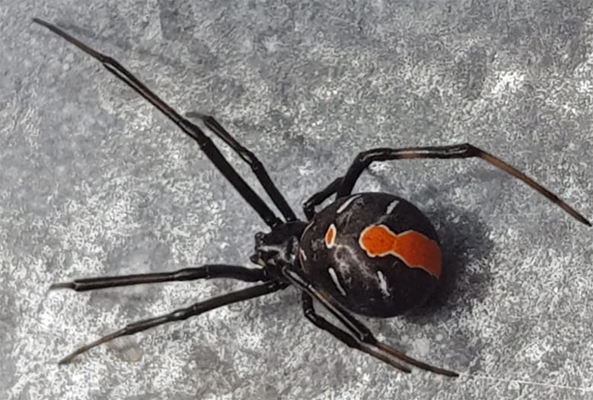See also
Spider Bite - Big Black Spider
Poisoning – Acute guidelines for initial management
Resuscitation
Key points
- Redback bites can cause severe pain and adequate analgesia is a priority
- Redback spiders rarely cause significant envenoming
- Necrotising arachnidism is a skin syndrome of unknown aetiology with small ulcers to spreading necrosis. It has been shown to be unrelated to spider bites
For 24 hour advice, contact Victorian Poisons Information Centre 13 11 26
Background
The female redback spider (Latrodectus hasselti) is the major significant venomous spider in Victoria. She is very unlikely to cause life-threatening envenomation. Redbacks usually live outside in dry sheltered spaces such as cubby house, sheds, and the undersides of shelves.
Bites occur when contact is made with the spider in its web, as they rarely leave their web.
Cupboard/ brown house spiders (Steatoda species) also cause similar symptoms and are treated in the same manner as red backs.
Other spiders, including white tailed spiders (Lampona sp), may cause minor symptoms such as local irritation/ inflammation.
Children requiring assessment
Patients with pain which is not controlled by simple analgesia
Risk Assessment
History
Diagnosis is made on the basis of a typical history. A spider may be seen.
If the spider is caught, she can be identified by being about 1 cm, with a red-orange strip / spot on her black, globular abdomen.

Severity is determined by the clinical picture of the severity of pain and any associated systemic features.
History
Pain
- The bite is not immediately painful however pain at the bite site develops increasing over minutes to hours
- Radiating from the bite site to regional lymph nodes, proximal limb, abdomen, chest or back
- May last for days
- May present as intractable crying in an infant
Generalised symptoms
- Headache
- Lethargy, malaise
- Nausea and vomiting
- Myalgia and neck spasm may occur
Examination
Local
- Fang marks are occasionally visible (5%)
- Local sweating, piloerection or erythema may develop over 1 hour
Systemic
- Sweating – local or regional in unusual distributions
- Autonomic features may include hypertension, irritability, and agitation; they are possibly seen more commonly in children than adults
- Priapism may occur
- Rarely rhabdomyolysis, myocarditis
Investigations
Nil usually required. CK or ECG may be required if features suggestive of rhabdomyolysis or myocarditis.
Acute Management
First aid:
- Ice pack
- Pressure immobilisation is NOT used
Treatment
Adequate
analgesia is a priority
- Paracetamol 15 mg/kg (1 g) and ibuprofen 10 mg/kg (400 mg)
- +/- oxycodone 0.1 mg/kg (5 mg), +/- fentanyl
Antivenom
Discuss with a toxicologist (Victoria Poisons Information Centre - 13 11 26) if there is inadequate response to analgesia. The primary aim of antivenom is to provide pain relief, so adequate analgesia should be provided first, particularly as there is not strong evidence to support the effect of antivenom. The risks /
benefits should be discussed with the patient / family prior to administration.
There is a risk of acute hypersensitivity reaction of
<5% (3.6% - 5.2) (see anaphylaxis). Premedication is not required. Once treated, the antivenom can be recommenced slowly. There is risk of serum sickness at 5-14 days (see Serum Sickness).
Dose: 2 ampoules (500 units each) CSL Redback Spider Antivenom, diluted in 10 ml/kg up to 100 ml, IV over 20 - 30 minutes
If IV access is difficult, undiluted antivenom can be given IM.
If no effect in 2 hours, reconsider diagnosis and discuss with a clinical toxicologist via the Poisons Information Centre.
Consider consultation with local paediatric team when
Consult Victorian Poisons Information Centre 13 11 26 for advice if considering antivenom, or in cases of delayed presentation.
Admission is not usually required.
Consider transfer to a tertiary centre when
Transfer is unlikely to be required as Red Back Spiders probably do not cause life threatening envenoming and resuscitation should not be required, however contact PIPER regarding any patient who does need resuscitation or treatment outside the comfort zone of the treating clinicians or hospital
For
emergency advice and paediatric or neonatal ICU transfers, call the Paediatric
Infant Perinatal Emergency Retrieval (PIPER) Service: 1300 137 650.
Consider discharge when
- Adequate pain control
- Patients should be observed for at least 1 hour after antivenom for recurrence of symptoms.
Discharge information and follow-up
Last updated January 2019